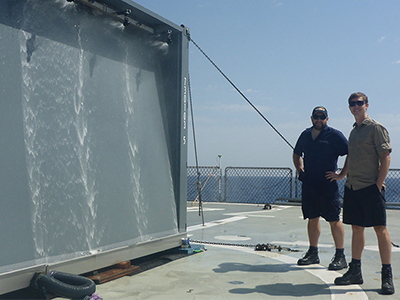DST thinking saves NATO trial

Faced with the possible cancellation of an important NATO trial of Infrared (IR) suppression technologies due to the unavailability of a suitable vessel, Defence Researcher, Ian Kermonde had a simple but novel solution – build a test article that mimics the side of a ship.
The idea involved building a shipping container with sides made from the same thickness and insulation levels as steel, as well as the same profile used on a frigate.
The DST Containerized Washdown System was used to investigate the behaviour of a type of signature suppression called a water washdown system, where a water jet is sprayed across and down the hull and parts of the ship superstructure.
Many ships have washdown systems installed to flush toxic chemicals off the ship following exposure, however the NATO Defence scientists were looking at their potential to cool the vessel and thereby reduce its IR signature.
Australia’s new Helicopter Landing Dock and Air Warfare Destroyer ships are fitted with zoned water washdown systems, with sensors to specifically control their operation.
“As scientists, we want to understand the IR signature consequences of different cooling rates, the consequences of changing flow rates, the effects of evaporation and movement of ships,” says Defence Research Leader, Leo de Yong.
“You can sit down and do the theoretical calculations, but as we all know, theory doesn’t always match reality perfectly.”
It took over six months for the team at Defence Science and Technology Group (DST) to flesh out the design of DST Containerized Washdown System, ensuring the design could be easily carried by the ships that would be available for the trial.
The two week trial using DST Containerized Washdown System not only produced valuable data which will inform the operation of the IR suppression systems on various naval vessels; it also introduced an efficient and cost effective method of exploring IR suppression technologies and produced a piece of equipment that can be used by countries around the world for their own research purposes.

